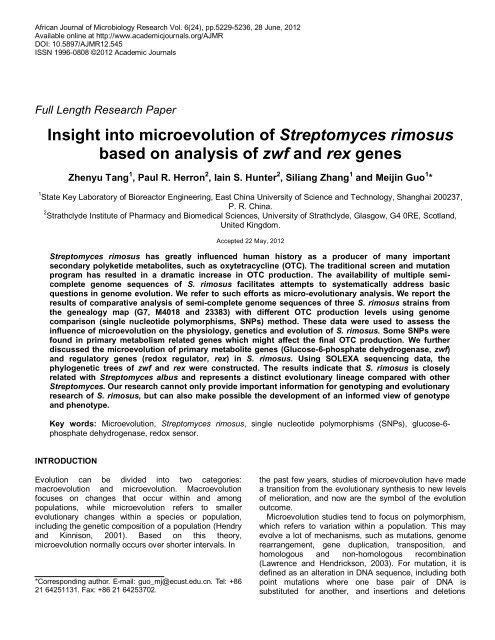Microbiology Research - Academic Journals
Microbiology Research - Academic Journals
Microbiology Research - Academic Journals
Create successful ePaper yourself
Turn your PDF publications into a flip-book with our unique Google optimized e-Paper software.
African Journal of <strong>Microbiology</strong> <strong>Research</strong> Vol. 6(24), pp.5229-5236, 28 June, 2012<br />
Available online at http://www.academicjournals.org/AJMR<br />
DOI: 10.5897/AJMR12.545<br />
ISSN 1996-0808 ©2012 <strong>Academic</strong> <strong>Journals</strong><br />
Full Length <strong>Research</strong> Paper<br />
Insight into microevolution of Streptomyces rimosus<br />
based on analysis of zwf and rex genes<br />
Zhenyu Tang 1 , Paul R. Herron 2 , Iain S. Hunter 2 , Siliang Zhang 1 and Meijin Guo 1 *<br />
1 State Key Laboratory of Bioreactor Engineering, East China University of Science and Technology, Shanghai 200237,<br />
P. R. China.<br />
2 Strathclyde Institute of Pharmacy and Biomedical Sciences, University of Strathclyde, Glasgow, G4 0RE, Scotland,<br />
United Kingdom.<br />
Accepted 22 May, 2012<br />
Streptomyces rimosus has greatly influenced human history as a producer of many important<br />
secondary polyketide metabolites, such as oxytetracycline (OTC). The traditional screen and mutation<br />
program has resulted in a dramatic increase in OTC production. The availability of multiple semicomplete<br />
genome sequences of S. rimosus facilitates attempts to systematically address basic<br />
questions in genome evolution. We refer to such efforts as micro-evolutionary analysis. We report the<br />
results of comparative analysis of semi-complete genome sequences of three S. rimosus strains from<br />
the genealogy map (G7, M4018 and 23383) with different OTC production levels using genome<br />
comparison (single nucleotide polymorphisms, SNPs) method. These data were used to assess the<br />
influence of microevolution on the physiology, genetics and evolution of S. rimosus. Some SNPs were<br />
found in primary metabolism related genes which might affect the final OTC production. We further<br />
discussed the microevolution of primary metabolite genes (Glucose-6-phosphate dehydrogenase, zwf)<br />
and regulatory genes (redox regulator, rex) in S. rimosus. Using SOLEXA sequencing data, the<br />
phylogenetic trees of zwf and rex were constructed. The results indicate that S. rimosus is closely<br />
related with Streptomyces albus and represents a distinct evolutionary lineage compared with other<br />
Streptomyces. Our research cannot only provide important information for genotyping and evolutionary<br />
research of S. rimosus, but can also make possible the development of an informed view of genotype<br />
and phenotype.<br />
Key words: Microevolution, Streptomyces rimosus, single nucleotide polymorphisms (SNPs), glucose-6phosphate<br />
dehydrogenase, redox sensor.<br />
INTRODUCTION<br />
Evolution can be divided into two categories:<br />
macroevolution and microevolution. Macroevolution<br />
focuses on changes that occur within and among<br />
populations, while microevolution refers to smaller<br />
evolutionary changes within a species or population,<br />
including the genetic composition of a population (Hendry<br />
and Kinnison, 2001). Based on this theory,<br />
microevolution normally occurs over shorter intervals. In<br />
*Corresponding author. E-mail: guo_mj@ecust.edu.cn. Tel: +86<br />
21 64251131. Fax: +86 21 64253702.<br />
the past few years, studies of microevolution have made<br />
a transition from the evolutionary synthesis to new levels<br />
of melioration, and now are the symbol of the evolution<br />
outcome.<br />
Microevolution studies tend to focus on polymorphism,<br />
which refers to variation within a population. This may<br />
evolve a lot of mechanisms, such as mutations, genome<br />
rearrangement, gene duplication, transposition, and<br />
homologous and non-homologous recombination<br />
(Lawrence and Hendrickson, 2003). For mutation, it is<br />
defined as an alteration in DNA sequence, including both<br />
point mutations where one base pair of DNA is<br />
substituted for another, and insertions and deletions

















